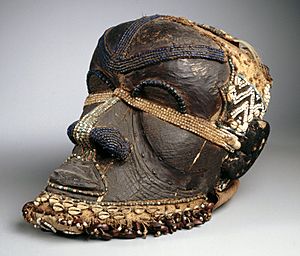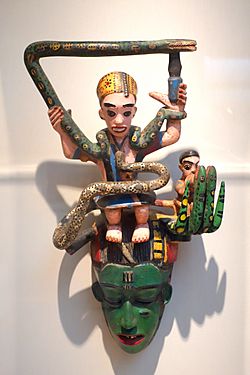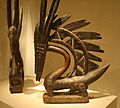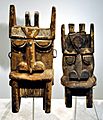African art facts for kids
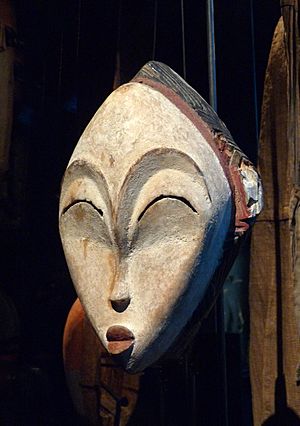
African art is any form of art or material culture that originates from the continent of Africa. This article talks mainly about visual art (art you can see). For information on African music, see Music of Africa.
Contents
Themes of African Art
- Utilitarian: A key characteristic of traditional African art is that it is utilitarian. It is more than just for looks; it is intended to be used. African art consisted of everyday items that were decorated and regularly used.
- Formal Innovation: Unlike Western societies, where art tends to be made by following rules, many African societies encourage innovation and creativity of both style and form among their artists. This seems to be seen all over Africa and over long periods.
- Visual abstraction: African artworks tend to be less life-like and more abstract. This is because many African artworks, regardless of how they are made, tend to represent objects or ideas rather than show them accurately.
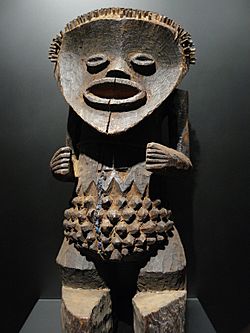
- Emphasis on Sculpture: African artists tend to prefer three-dimensional artworks over two-dimensional works. Even many African paintings or cloth works were meant to be experienced three-dimensionally.
- Emphasis on Performance Art: African art uses utilitarianism and three-dimensionality for use in performances. For example, masks and costumes are often used in communal, ceremonial contexts, where they are "danced." Most societies in Africa have names for their masks. They put a lot of thought into the name because the single name represents the whole sculpture: the meanings of the mask, the dance associated with it, and the spirits that reside within. In African thought, the three cannot be separated.
- Multiplicity of Meaning: Symbols and forms in African art are usually meant to represent different things to different members of society. This is different from "Western" Christian iconographic customs where a symbol is normally linked with only one meaning (for example the cross as a symbol of the crucifixion of Jesus Christ).
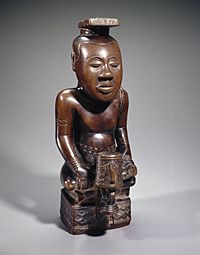
History of African art

The beginning of African art was before recorded history. African rock art in the Sahara in Niger preserves 6,000-year-old carvings. The art of the western tribes, the Egyptian area, and indigenous southern crafts all added much to African Art. Their art usually showed animals, plant life, or natural designs and shapes were abstract. Abstract art is art that shows things that are not accurate to the way they look in life. Sometimes abstract art is simply bright colors and shapes that are put together creatively.
Influence on Western art
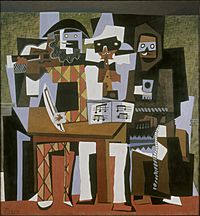
The twentieth century brought some famous abstract artists like Picasso, Matisse, and Modigliani. These men were inspired by abstract African sculptures in their search for new ways to express themselves through art. The cubist movement analyzed traditional African masks and showed them as more than simply pieces that showed what a particular culture was like but rather as works of art.
Traditional art
Traditional art describes the most popular and studied forms of African art. These pieces of art are usually found in museum collections. Wooden masks, which could either be human or animal, are one of the most commonly found forms of art in western Africa. Originally, ceremonial masks are used by actors and dancers in performances.
Ivory, animal hair, plant fibers such as raffia, pigments, like kaolin, stones, and semi-precious gems also are included in the masks. Statues, usually of wood or ivory, are often inlaid with cowrie shells, metal studs, and, in some cases, nails.
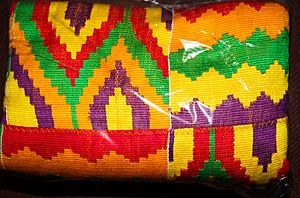
Decorative clothing is also common and makes up another large part of African art. Among the most complex of African fabrics is the colorful, strip-woven Kente cloth of Ghana.
Various art styles by country
Côte d'Ivoire
The Baoulé, the Senoufo, and the Dan peoples are skilled at carving wood, and each culture produces a wide variety of wooden masks. The Côte d'Ivorian peoples use masks to represent animals to represent gods or the souls of the dead.
Because the masks are thought to possess spiritual power, only specially trained people are allowed to wear or own certain masks. These ceremonial masks each are thought to have a soul, or life force, and wearing these masks is thought to transform the wearer into the person that the mask represents.
Botswana
In the northern part of Botswana, tribal women in the villages of Etsha and Gumare are known for their skill at making baskets from Mokola Palm and local dyes. The baskets are woven into three types: large, lidded baskets used for storage; large, open baskets for carrying objects on the head or for inspecting threshed grain; and smaller baskets for inspecting pounded grain.
The artistry of these baskets is being gradually improved through color use and enhanced designs. This is because now they are making them so that they can sell them to others.
The oldest evidence of ancient paintings comes from both Botswana and South Africa. Depictions animals and humans hunying were made by the Khoisan (indigenous people of southern Africa) and date before civilization was recorded.
Egypt

Continuing for 3,000 years and thirty dynasties, Egypt's "official" art was centered on the state religion of the time. The art ranged from stone carvings of both massive statues and small statuettes to wall art that depicted both history and mythology. In 2600 BC, carvings stopped improving and did not start again for another 1500 years. This improvement began again during the reign of Rameses II.
Much of Egypt’s art possesses a certain stiffness, with figures poised upright and rigid in a most royal fashion. It appears that math was used to show accurate bodily proportions. This perfection was most likely used to highlight the godliness of the ruling class.
The style and smoothness of the human form in Egyptian art of this era far outdid the art in Greece, which often contained an inaccurate picture of the areas between the torso and pelvis, and the pelvis and thigh.
Quick facts about African art
- The beginning of African art was before recorded history.
- African art was made for more than just beauty. Their art was used in everyday life.
- African art (except Egyptian art) was not meant to show animals, plants, and other artistic expressions accurately. It was more abstract.
- African art usually had more than one meaning, and viewers saw differing meanings when they looked at it.
- Some African art was made to be used in performances.
- Masks were thought to possess life and power, so only trained people could wear them.
Images for kids
-
Fest für Neptun, sculpture on the outside areas of the building of the Deutsche Welle (Schürmann-Bau) in Bonn
-
Two Bambara Chiwara c. late 19th early 20th centuries, Art Institute of Chicago. Female (left) and male Vertical styles
-
Bobo Mask (Nyanga) from Burkina Faso, made in the early 19th century. Brooklyn Museum
-
Bet Maryam church, Lalibela. Traditional Ethiopian church art
-
Modern Makonde carving in ebony
-
Nok seated figure; 5th century BC – 5th century AD; terracotta; 38 cm (1 ft. 3 in.); Musée du quai Branly (Paris). In this Nok work, the head is dramatically larger than the body supporting it, yet the figure possesses elegant details and a powerful focus. The neat protrusion from the chin represents a beard. Necklaces from a cone around the neck and keep the focus on the face.
-
Relief fragment with heads and figures; 5th century BC – 5th century AD; length: 50 cm (19.6 in.), height: 54 cm (21.2 in.), width: 50 cm (19.6 in.); terracotta; Musée du quai Branly. As most African art styles, the Nok style focuses mainly on people, rarely on animals. All of the Nok statues are very stylized and similar in that they have this triangular shape eye with a perforated pupil, with arched eyebrows.
-
Male head; 550–50 BC; terracotta; Brooklyn Museum (New York City, USA). The mouth of this head is slightly open. It maybe suggests speech, that the figure has something to tell us. This is a figure that seems to be in the midst of a conversation. The eyes and the eyebrows suggest an inner calm or an inner serenity.
-
Male figure; terracotta; Detroit Institute of Art (Michigan, USA)
-
Maiden spirit mask; early 20th century; wood & pigment; Brooklyn Museum (New York City, USA)
-
A mask known as the Queen of Women (Eze Nwanyi); late 19th-early 20th century; wood & pigment; Birmingham Museum of Art (Alabama, USA)
-
Bronze ornamental staff head; 9th century; Igbo-Ukwu; Nigerian National Museum
-
Bronze head from Ife; 12th–15th century; brass; British Museum (London)
-
Gelede mask; circa 1900–1915; Detroit Institute of Arts (USA)
-
Pair of door panels and a lintel; circa 1910–1914; by Olowe of Ise; (British Museum, London)
-
Carved door; circa 1920–1940; wood with iron staples; by Nupe people; Hood Museum of Art (Hanover, New Hampshire, USA)
-
Headdress; early 1900s; wood, antelope skin, basketry, cane, metal; by Ejagham people; Cleveland Museum of Art (USA)
-
Otobo (hippopotamus) mask; by Kalabari people; British Museum (London)
-
Stool; possibly late 19th to early 20th century; wood & pigment; National Museum of African Art (Washington D.C., USA)
-
Black and white picture of a female figure with raised arm; 15th–17th century; wood (ficus, moraceae), sacrificial materials; height: 44.8 cm (175⁄8 in.); by the Tellem people; Metropolitan Museum of Art (New York City)
-
Zoomorphic figurine; 12th-16th century; by Tennenkou culture; Museo de Arte Africano Arellano Alonso (Valladolid, Spain)
-
Figurine of a standing woman; late 19th or early 20th century; wood; 27.9 × 8.3 × 10.2 cm (11 × 31⁄4 × 4 in.); Brooklyn Museum (New York City)
-
Kifwebe mask; wood; Royal Museum for Central Africa (Tervuren, Belgium)
-
Antropomorphic figurine; terracotta; 9th-16th century; Musée du quai Branly (Paris)
-
Head; terracotta; Muséum d'Histoire naturelle de La Rochelle (La Rochelle, France)
-
Murals in the Ndebele from the Maastricht University (the Netherlands)
-
A beaded apron or meputo; late 19th-early 20th century; hide, glass beads, metal beads, straw; 46.9 × 50.8 cm (18.5 × 20 in.); Birmingham Museum of Art (Alabama, USA)
-
Both sides of the Narmer Palette; circa 3100 BC; greywacke; height: 63 cm (243⁄4 in.); from Hierakonpolis (Egypt); Egyptian Museum (Cairo). The Narmer palette is the quintessential statement of the Egyptians' mythology of kingship. A clear manifesto of royal power, it is also one with multiple layers of symbolism
-
The Bust of Nefertiti; 1352-1336 BC; limestone, plaster & paint; height: 48 cm (197⁄8 in.); from Amarna (Egypt); Egyptian Museum of Berlin (Germany). Perhaps the most iconic image of a woman from the ancient world, the bust of Nefertiti is difficult to contextualize because it seems so exceptional
See also
 In Spanish: Arte africano para niños
In Spanish: Arte africano para niños


